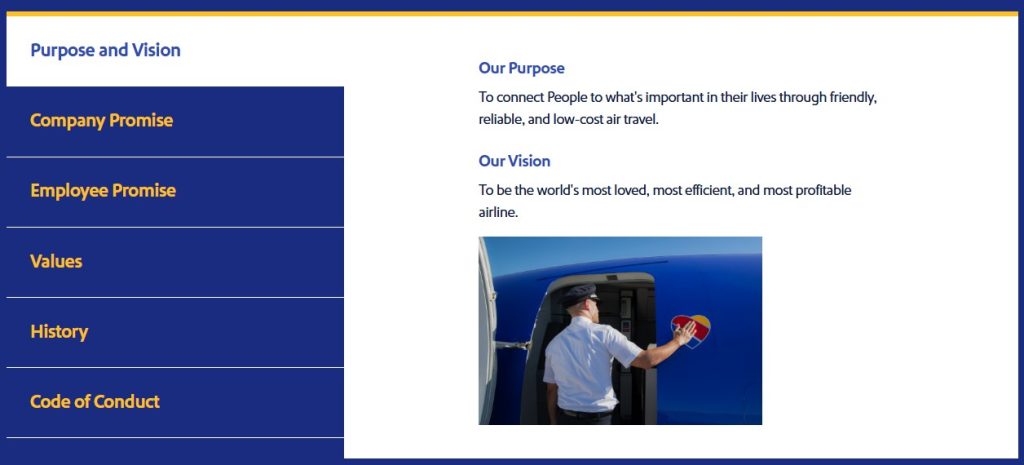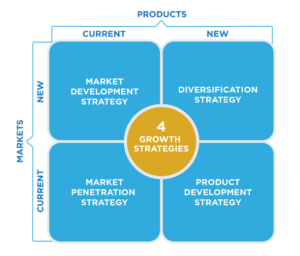4.7 Putting It Together: Marketing Strategy
Southwest Airlines
Since Southwest Airlines is a familiar example by now, let’s do a more complete review of its strategy to help with your assignments in this course.
In this module we have focused on the following aspects of marketing planning:
- Evaluate marketing strategies for alignment with the organization’s corporate strategies
- Show how common analytic tools are used to inform the organization’s strategy
- Explain inputs and components of a marketing strategy
- Give examples of corporate strategies
- Explain how the development and maintenance of customer relationships are an essential part of an organization’s marketing strategy
The summary below shows one analysis of the planning process for Southwest Airlines:
Corporate Strategy
Southwest Airlines’ corporate strategy continues to be grounded in its enduring purpose:
Connect people to what’s important in their lives through friendly, reliable, and low-cost air travel.1
This mission reflects a broader commitment to customer-centric service, not limited to leisure or budget travelers. It underscores Southwest’s focus on building meaningful connections through accessibility, simplicity, and warmth across every segment of air travel.

A recent industry analysis from Airline Weekly summarizes the company’s positioning:
“Southwest remains unique among U.S. carriers—not just in its low-cost origins but in how its corporate culture translates into tangible value for customers. In a landscape of upselling and nickel-and-diming, Southwest offers two free checked bags, no change fees, and a level of brand trust unmatched by its competitors.”2
Southwest has built a legacy on operational efficiency, employee engagement, and exceptional service. From its modest beginnings in 1971, flying between Texas cities with a few aircraft, the airline has grown into one of the largest domestic carriers in the United States. In 2023, Southwest flew over 129 million passengers and maintained one of the highest customer satisfaction ratings among U.S. carriers.3
However, Southwest has not been immune to industry pressures. Following disruptions in late 2022 and growing competition from ultra-low-cost carriers, the airline sharpened its focus on digital transformation, fleet modernization, and enhancing the customer experience.
A key corporate objective heading into 2025 has been to regain operational trust and to grow revenue through increased loyalty and digital self-service tools. The airline is also doubling down on business travel by expanding its corporate booking tools and simplifying fare structures to better meet business customer needs.
While past objectives included increasing the share of business travelers from 35% to 40% between 2014 and 2019, the current goal is to rebuild and diversify its customer base following pandemic-era declines. As CEO Bob Jordan noted in 2024:
“We’re moving fast to restore customer confidence, modernize our operations, and drive long-term growth—while staying true to our roots.”4
Analysis Tools
In order to achieve the company objective Southwest needs to bring its strengths to new customers in a way that addresses both its own weaknesses and those of competitors (which create opportunities).
SWOT Analysis
Southwest’s SWOT analysis, below, identifies a number of opportunities and challenges:
Strengths
-
Strong balance sheet and liquidity (approx. US $12.5B in cash reserves)
-
Industry-leading low-cost carrier with competitive fare value
-
Well-known for a positive, employee-centric “LUV” culture; strong employer reputation
-
High brand recognition; consistently ranks among most admired U.S. companies
Weaknesses
-
Limited international and long-haul route network compared to competitors
-
Dependence on a single aircraft type (Boeing 737), reducing operational flexibility
-
Persistent IT infrastructure issues, including outdated scheduling systems
-
Recent introduction of bag fees and layoffs may erode long-standing customer loyalty
Opportunities
-
Expansion of fare options (e.g., assigned seating, Business Select upgrades)
-
Increased focus on corporate travel through the SWABIZ booking platform
-
International growth through new codeshare agreements (e.g., with Icelandair)
-
Sustainability initiatives could attract ESG-focused travelers and partners
Threats
-
Volatility in fuel prices and rising labour costs strain margins
-
Major airlines aggressively targeting high-margin business travelers
-
Legal and regulatory scrutiny over service disruptions and fee changes
-
Repeated IT outages or scheduling failures may continue to damage reputation
Strategic Opportunities Matrix
In recent years, Southwest Airlines has sought to expand its appeal to higher-yield business travelers in an effort to diversify its customer base and boost revenue. While the airline has traditionally served cost-conscious leisure travelers, this strategic shift represents a market development approach, introducing its existing product to a new customer segment.
Rather than overhauling its core offering, such as adding premium cabins or luxury amenities, Southwest has focused on refining elements of the marketing mix, specifically pricing, promotion, and distribution, to attract business travelers. Examples include enhanced fare classes like Business Select, expanding SWABIZ, its corporate booking tool, and forging new codeshare partnerships to increase flight flexibility for corporate clients.
This strategy is well aligned with Southwest’s mission of providing friendly, reliable, and affordable air travel, and it allows the company to extend its well-regarded customer service into the business segment without compromising its low-cost model.
The move also leverages key strengths identified in Southwest’s SWOT analysis, such as brand loyalty, strong balance sheet, and customer service culture, while addressing weaknesses like low revenue per passenger, limited long-haul service, and operational bottlenecks. However, the strategy must be executed carefully, given ongoing threats from increased competition, rising labor and fuel costs, and potential disruptions in technology infrastructure.
4 Growth Strategies: The Strategic Opportunities Matrix

The following is a list of the four growth strategies in the Strategic Opportunities Matrix:
- Market Development Strategy: New market and current product
- Diversification Strategy: New market and new product
- Market Penetration Strategy: Current market and current product
- Product Development Strategy: Current market and new product
Components of the Marketing Strategy
In order to appeal to corporate customers, Southwest must focus all elements of the marketing mix on a new target customer that is less cost-conscious and less patient with the inconveniences of travel.
Marketing Mix
Southwest Airlines has not approached each of the four Ps—product, price, promotion, and place—as isolated strategies. Instead, the company has bundled these elements into integrated initiatives designed to support its entry into the higher-yield business travel market, while maintaining its strong position among leisure travelers.
Business Select Offering
Southwest’s Business Select fare continues to offer enhanced value for time-sensitive and convenience-focused business travelers. This service tier includes early boarding, priority check-in and security access, complimentary premium drinks, and bonus frequent-flyer points. The product is not a luxury experience, but rather a targeted value proposition—offering speed, flexibility, and efficiency at a price point that remains lower than most competitors’ business-class options.
By refraining from adding first-class cabins or drastically altering its aircraft configuration, Southwest preserves its low-cost structure while using pricing and packaging to differentiate the offering. In a post-pandemic environment, where flexibility and reliability are prized, the Business Select strategy allows the airline to charge a premium without alienating its core customer base.
SWABiz and Expanded Distribution Channels
Historically, Southwest has preferred to sell directly to consumers through its own channels: website and customer service centers, avoiding third-party travel platforms. However, recognizing its low visibility among corporate travel managers, Southwest expanded its distribution strategy.
SWABiz, a dedicated booking and expense management platform for corporate clients, now offers companies an easy way to book travel, monitor expenses, enforce travel policies, and access exclusive pricing. In addition to SWABiz, Southwest has partnered with major corporate travel management systems like SAP Concur, allowing business travelers to view and book Southwest flights alongside those from competitors—effectively breaking down a long-standing barrier to business market entry.
These distribution enhancements are supported by targeted promotional efforts, including digital campaigns and partnerships that specifically highlight Southwest’s reliability, value, and customer service for business audiences.
Southwest’s integrated marketing mix, combining upgraded service tiers, refined pricing, broader distribution, and strategic promotion, reflects its commitment to customer-centric growth. It supports both short-term business acquisition goals and long-term brand equity by reinforcing the airline’s reputation for friendly, efficient, and affordable service.
Evaluation
Are these strategies successful? Southwest Airlines continues to actively monitor its progress in attracting business travelers while adapting to changing market conditions. As with most long-term strategies, the results are mixed, and there is ongoing pressure to refine and innovate.
CEO Bob Jordan remains optimistic about the airline’s evolving approach to corporate travel, though he acknowledges ongoing challenges. In April 2025, Jordan stated, “We’ve seen a steep drop-off in business travel demand—it’s probably the most that I have seen absent COVID.”1 This comment came as Southwest was rolling out initiatives like new fare tiers, expanded distribution partnerships, and product enhancements designed to better serve business travelers.
Despite current headwinds, the airline is making strategic moves to reposition itself for future growth. New routes are being added at major airports, digital tools are being upgraded to support corporate bookings, and customer experience upgrades—such as improved seating options and streamlined check-in—are being implemented across the fleet.
These efforts reflect a continued commitment to competing more effectively in the business travel segment. Still, as Jordan’s comments suggest, success in this space requires ongoing evaluation and flexibility. The work of defining, implementing, measuring, and adjusting strategy is never finished.
- Southwest Airlines. (n.d.). Purpose and Vision. ↩
- Airline Weekly. (2023, October 12). Why Southwest Still Stands Out in the U.S. Airline Industry. ↩
- Southwest Airlines. (2024). Annual Report 2023. ↩
- Southwest Airlines. (2024, April 25). Q1 Earnings Call Transcript. CNBC. ↩
- “CNBC. (2025, Apr 24). Southwest CEO: There is definitely economic weakness on the consumer side.
Creation note: This section was drafted with the assistance of ChatGPT, a language model developed by OpenAI, and reviewed by the author for clarity and accuracy.

